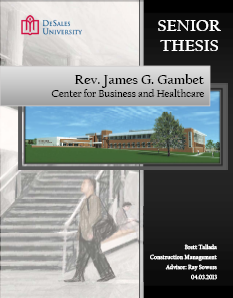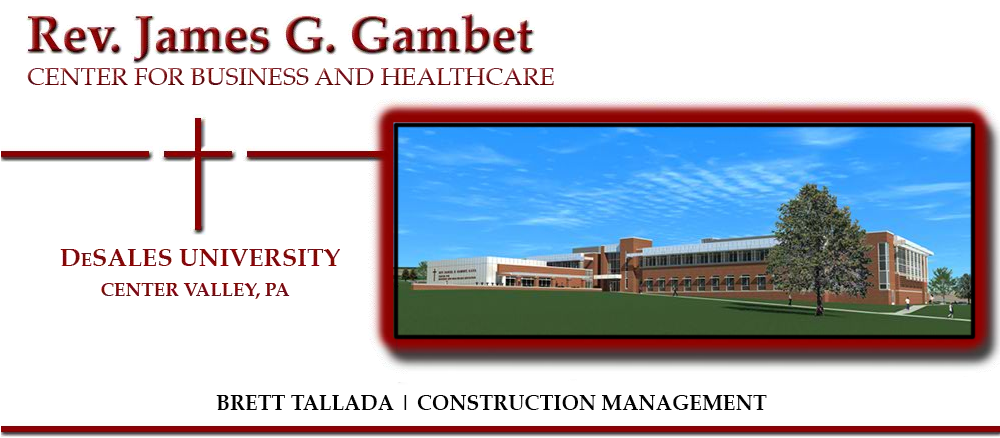
|
 |
Final Report | 4.3.13
The Reverend James G. Gambet Center for Business and Healthcare is the latest addition to the campus at DeSales University. The new $27 million facility, which is the new home of the Business, Nursing, and Physician Assistant Programs, is state of the art and includes technologically advanced labs and classrooms. DeSales’ continual growth and ever increasing quality in education has caused these programs to reach their maximum potential in the current facilities. Construction of the 77,000 square foot building is managed by Alvin H. Butz, Inc., and was completed in January 2013.
DeSales University has recently made large strides to integrate practices in sustainability throughout the campus, and the McShea Student Center was the University’s first LEED® rated building. The Gambet Center is expected to achieve 50 LEED® credits to achieve a Silver rating. Four technical analyses in energy modeling, green roof implementation, on-site renewable energy, and advanced lighting controls were conducted to evaluate the building’s potential to obtain 10 additional LEED® credits to be awarded a Gold status.
TECHNICAL ANALYSIS I: CONCEPTUAL ENERGY MODELING
The minimal use of Building Information Modeling on the project led to an opportunity to reduce The Gambet Center’s energy consumption. Through utilization of Autodesk Project Vasari, it was determined that early use of energy modeling to compare alternative design options would have been effective in reducing energy costs. The software’s energy analysis tool calculated an annual savings of $7,990 when reducing exterior glazing from 38 to 25 percent of the total area of the envelope. A savings of $13,434 was also estimated when considering a ground source heat pump for the HVAC system instead of the as-designed packaged gas VAV system.
TECHNICAL ANALYSIS II: GREEN ROOF IMPLEMENTATION
The Lecture Hall of the Gambet Center was originally an alternate bid, the inclusion of which requires two additional rooftop air handling units. A new 5,855 square foot green roof consisting of GroRoofTM hybrid green roof modules was designed. A structural breadth determined that the currently designed structure provides ample support for the added structural load of the system. A mechanical analysis estimated an annual savings of $147.68 in cooling costs. Grouped with tax incentives and an extended 40 year service life, the system will pay itself back in 25 years with a $22,263 return on investment. The low energy savings of the implementation suggests negligible effect on energy efficiency of the building, and as a result, no LEED® credit gains are expected.
TECHNICAL ANALYSIS III: ON-SITE RENEWABLE ENERGY
A combination rooftop and parking lot canopy photovoltaic array was considered in this analysis to generate 13 percent of the building’s electricity to achieve 7 LEED® credits. The proposed 193 kilowatt system was determined to produce 220,894 ($21,206) kilowatt hours per year, equivalent to 26 percent of the building’s power usage. Tax incentives and Solar Renewable Energy Credits also help to pay for the system in the 22nd year of the 25 year lifespan. The goal of 13 percent was doubled, and therefore a more economically feasible system is recommended that has a 15 year payback period and a 21 percent return on investment.
TECHNICAL ANALYSIS IV: ADVANCED LIGHTING CONTROLS
The original design of the Gambet Center includes a centralized Lutron Quantum® Total Light Management lighting control system. An expansion of this system to include the faculty offices, breakout, and conference rooms was studied to determine energy savings and effect on the LEED® rating. Although the upgraded system reduces the lighting load by 8 percent, the energy savings were not enough to obtain additional LEED® credits. Regardless of the unchanged LEED® rating, the system is recommended for implementation due to its low cost, 5 year payback period, and a lifetime return of $13,471.
When combining the effects studied in the technical analyses, and evaluating the effect on the LEED® rating of the building, it is not possible to achieve Gold with these solutions. When considering use of certified wood with a 10,000 gallon rainwater harvest system, the 3 available LEED® credits can be obtained to reach Gold. Alternatively, the unfavorably expensive ground source heat pump option investigated in Technical Analysis I can be implemented for an estimated cost increase of $584,440. This correlates to a gain of 6 LEED® points, which easily achieves a Gold rating. |













